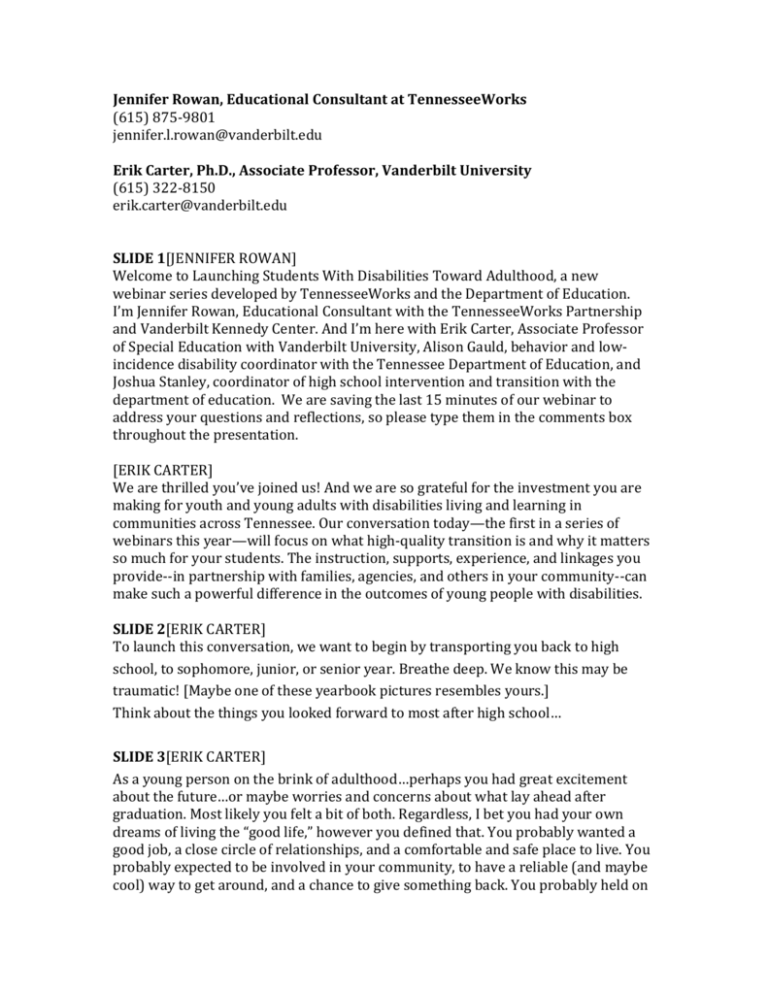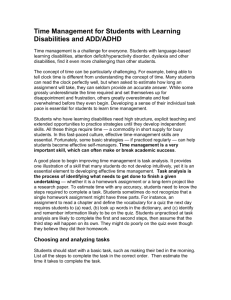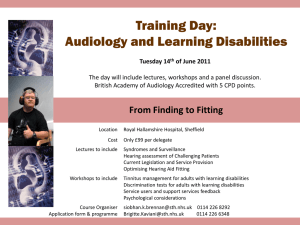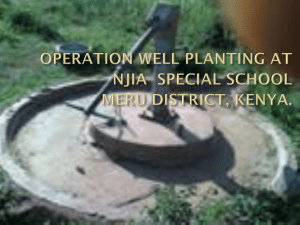Click here for a transcript of the video
advertisement

Jennifer Rowan, Educational Consultant at TennesseeWorks (615) 875-9801 jennifer.l.rowan@vanderbilt.edu Erik Carter, Ph.D., Associate Professor, Vanderbilt University (615) 322-8150 erik.carter@vanderbilt.edu SLIDE 1[JENNIFER ROWAN] Welcome to Launching Students With Disabilities Toward Adulthood, a new webinar series developed by TennesseeWorks and the Department of Education. I’m Jennifer Rowan, Educational Consultant with the TennesseeWorks Partnership and Vanderbilt Kennedy Center. And I’m here with Erik Carter, Associate Professor of Special Education with Vanderbilt University, Alison Gauld, behavior and lowincidence disability coordinator with the Tennessee Department of Education, and Joshua Stanley, coordinator of high school intervention and transition with the department of education. We are saving the last 15 minutes of our webinar to address your questions and reflections, so please type them in the comments box throughout the presentation. [ERIK CARTER] We are thrilled you’ve joined us! And we are so grateful for the investment you are making for youth and young adults with disabilities living and learning in communities across Tennessee. Our conversation today—the first in a series of webinars this year—will focus on what high-quality transition is and why it matters so much for your students. The instruction, supports, experience, and linkages you provide--in partnership with families, agencies, and others in your community--can make such a powerful difference in the outcomes of young people with disabilities. SLIDE 2[ERIK CARTER] To launch this conversation, we want to begin by transporting you back to high school, to sophomore, junior, or senior year. Breathe deep. We know this may be traumatic! [Maybe one of these yearbook pictures resembles yours.] Think about the things you looked forward to most after high school… SLIDE 3[ERIK CARTER] As a young person on the brink of adulthood…perhaps you had great excitement about the future…or maybe worries and concerns about what lay ahead after graduation. Most likely you felt a bit of both. Regardless, I bet you had your own dreams of living the “good life,” however you defined that. You probably wanted a good job, a close circle of relationships, and a comfortable and safe place to live. You probably expected to be involved in your community, to have a reliable (and maybe cool) way to get around, and a chance to give something back. You probably held on to some important hopes and dreams. SLIDE 4 [ERIK CARTER] Students with disabilities across our state share many of those same hopes and dreams. They too want to live a good life after high school. Listen to just a few of the students we met last month at the Think Employment! Summit in Nashville as they respond to a simple question we have all been asked ourselves: What do you want to be when you grow up? At the end of the day, students with disabilities want a good job, a chance for further education, and a life in their community. SLIDE 5[ERIK CARTER] It turns out that helping youth with disabilities make this transition to adulthood successfully is among the very central purposes of special education. Our primary charge as special educators is to equip young people with disabilities with the skills, opportunities, and relationships they need to flourish after high school. To live a good life however THEY and their families define it. SLIDE 6 [ERIK CARTER] For those of you who--like me--enjoy curling up at night in bed with the latest piece of federal legislation, you already know this. The Individuals with Disabilities Education Improvement Act--the federal law guiding special education services-explains one of the purposes of special education just a few pages in: ...to ensure that all children with disabilities have available to them a free and appropriate public education that emphasizes special education and related services designed to meet their unique needs and prepare them for further education, employment, and independent living.... SLIDE 7[ERIK CARTER] Notice this last bolded section. Helping students with disabilities attain good outcomes in these three specific areas is a big part of why we all do what we do for so many years of schooling. How do the services and supports you provide point to these outcomes? Can you draw a clear line between the instruction you provide in your school and the skills needed to attain these outcomes? SLIDE 8 [ERIK CARTER] It takes a coordinated set of planned efforts to make this happen. And here is where we find the mandate for those of us working with students ages 14 and older in our state. Turn a bit deeper into the IDEA law and you’ll find this definition of transition. Transition is a “coordinated set of activities for a child with a disability that is designed to be within a results-oriented process, that is focused on improving the academic and functional achievement of the child with a disability to facilitate the child’s movement from school to post-school activities.” And those post-school activities include: “post-secondary education, vocational education, integrated employment (including supported employment), continuing and adult education, adult services. independent living, or community participation” SLIDE 9[ERIK CARTER] Here is perhaps the key take-away from this mandate: The outcomes our students attain in early adulthood tells us something important about the quality and effectiveness of our transition services and supports. Put simply, their outcomes are heavily influenced by what we do or don’t do while they are still with us in high school. Transition is defined as a “results-oriented process,” rather than a process-focused activity. In other words, we can’t consider ourselves to be successful based on what we have written down on a transition plan; but on the degree to which the goals students have for life after high school actually materialize. SLIDE 10 [ERIK CARTER] This is why Indicator 14 is so very important. It is a measure of the percentage of young people with disabilities from your district who have left secondary school and are enrolled in in higher education, are competitively employed, or are in some other postsecondary education or training program within one year of leaving high school. It is a marker of whether the vision students have as they look out to their future related to college and career ever materializes. SLIDE 11[JENNIFER ROWAN] So...how are we doing as a state in terms of promoting successful transitions? How are you doing in your school or district? What is going well? What might you do even better, more of, or entirely differently? In our later webinars, we’ll be sharing more about the specific outcomes of Tennesseans with disabilities. For now, we want to give you a national picture of where we have been, where we are, and where we might go next. In the first two of those post-school outcome areas mentioned in IDEA—postsecondary education/training and employment. SLIDE 12[JENNIFER ROWAN] Let’s begin with postsecondary educational opportunities. Exciting things are happening in Tennessee. Conversations about college for students with disabilities—especially intellectual and developmental disabilities—are becoming more and more common. SLIDE 13[JENNIFER ROWAN] We are seeing more of our two- and four-year colleges and universities in Tennessee offer enrollment options for young adults with intellectual disability, autism, and other developmental disabilities. And most other colleges already offer disability support services for students with other disability labels. For example, the Think College project lists more than 200 formal college programs for students with intellectual disabilities in their databases. Four of these programs are here in Tennessee—Next Steps at Vanderbilt, Futures at UT-Knoxville, TigerLife at the University of Memphis, and IDEAL at Lipscomb. Other colleges are also having conversations about starting such programs. We’ve put a short “practice brief” on your screen that describes these programs. We’ll include the link when we post this webinar online on the TennesseeWorks website. SLIDE 14 [JENNIFER ROWAN] Yet, we still have a ways to go on this leg of the journey. According to findings from the National Longitudinal Transition Study-2--a representative ten-year study of more than 11,000 students, including about 1000 students in each of the disability categories--postsecondary enrollment remains elusive for substantial numbers of youth with disabilities . The figure I’ve put up on the screen show that less than half of youth with autism are enrolled in any type of postsecondary school (vocational, business, technical, 2-year, 4-year) up to two years after exciting high school, despite more than two-thirds (66%) having this as a transition goal during high school. And very, very few are attending four-year colleges or universities. Think about the pathways your own students take? What steps could you take to improve these outcomes in your district? What are the skills we should teach, the experiences we should provide, the coursework we should offer, the linkages we should make, and the encouragement we should offer? SLIDE 15 [JENNIFER ROWAN] What about the world of work? More and more young people with disabilities in our state are being provided opportunities to develop and contribute their skills and talents in the workplace. And more and more employers are discovering the contributions to productivity and workplace culture young people with disabilities can make--when the right fit is found. Graduating to unemployment…or even to sheltered employment…is no longer considered an acceptable expectation. SLIDE 16 [JENNIFER ROWAN] And there are plenty examples of employment successes all across our state in Tennessee. These are screenshots from the TennesseeWorks website. We are highlighting stories, videos, and other illustrations of the impact young people in our state can have if given the right preparation and linkages. It really can be done.’ SLIDE 17[JENNIFER ROWAN] Yet, we still have a ways to go on this leg of our journey. On the screen, you’ll see the percentage of students in each of the 12 different disability categories you have worked at any point up to 4 years after leaving high school. That is the blue bar. This is not continuous working…just even a single day. Some students are doing quite well. But others are struggling. It is the green bars where we have lots to do. SLIDE 18 [JENNIFER ROWAN] In Tennessee, less than 16% of all adults (ages 16-65) with cognitive impairments are employed. That means we have an unemployment rate of about 84%, perhaps even higher. SLIDE 19 [ERIK CARTER] What can we do to change the post-school landscape for our students? Our secondary schools really do represent a critical juncture. A period when we have the strongest chance of changing the trajectories—the post-school pathways—of our students. And the good news is that as a field, we have a growing number of research-based practices we can draw upon in this work. SLIDE 20 [ERIK CARTER] We have put on your screen several free guides on research-based practices in transition. They all highlight things we can do that predict better outcomes for students after high school. They all point to skills we can teach, experiences we can provide, expectations we can hold, supports we can provide, and linkages we can make. And they are surprisingly consistent in what they suggest. You can download these and read them. SLIDE 21[ERIK CARTER] We can’t address every important practice in this webinar series. Instead, we chose to highlight five of transition practices that are especially powerful and are considered absolutely essential to improving in- and post-school outcomes. These five practices are: (1) assessment, (2) early work experiences, (3) selfdetermination, (4) family engagement, and (5) strong partnerships with agencies and other community supports. SLIDE 22[JENNIFER ROWAN] No two students with disabilities in our state (or in your school) are quite the same. Just like we heard in the video that opened this webinar…our students have their own personal visions of what they want to do, how they want to live, and who they want to be after high school. And so our services and supports have to be individually tailored to align with those personal goals. Strong transition assessment helps us do that. SLIDE 23 [JENNIFER ROWAN] The first IEP to be in effect when a student with a disability turns 14 must include “appropriate measurable postsecondary goals based upon age-appropriate transition assessments related to training, education, employment, and, where appropriate, independent living skills.” The law doesn’t tell us which specific assessment tools we need to use. But best practice suggests transition assessment should be an ongoing process of collecting information on the student’s strengths, needs, preferences, and interests as they related to the demands of current and future living, learning, and working environments. There is much to unpack in that statement. And we’ll do so in the next webinar. SLIDE 24[JENNIFER ROWAN] For now, the important point is that we ought to be very intentional about doing the sort of data-driven assessment that helps our students (and their families) have solid answers to the types of questions we’ve listed on your screen. As you reflect on your own school, what types of assessment are you already using to learn about the strengths, interests, needs, and goals of your students? How are you determining which skills, supports, and linkages a particular student needs to achieve their goals for life after high school? SLIDE 25[ERIK CARTER] The second practice we will address is involves connecting students to early work and career-related experiences. It is a common experience for most teenagers to have a part-time job, an internship, or some type of volunteer experience at some point during high school. But not so for students with disabilities. This is a missed opportunity. Early work and career exploration experiences provide a meaningful context for learning functional and social skills, informing future career plans, expanding social networks and community connections, and promoting self-determination skills. When those high school work experiences are successful, they also raise the careerrelated expectations of youth, their parents, employers, and community members. SLIDE 26 [ERIK CARTER] If you want to change the post-school employment outcomes of your students, one of the most powerful things you can do is connect them to well-supported paid work experiences when they are still in high school. It makes a lot of sense. But our own research finds that students with severe disabilities who have had a paid job during high school are 2.5 times more likely to be employed after high school. How early should those work experiences come? Maybe not this early. But students with disabilities should have opportunities in middle and high school for career exploration experiences, job shadowing, service-learning, internships and apprenticeships, involvement in school-based enterprises, and job sampling. And before they graduate: paid employment. As you reflect on your own school, what types of work-related experiences are you already providing to your students? What sort of resume-building experiences are they getting? Where are they learning about what they want to do for a future job, what they definitely don’t want to do, and what skills they will need to find and keep such a job? These are all topics we’ll explore in greater depth in the third webinar. SLIDE 27 [JENNIFER ROWAN] The third practice we will address is all about promoting self-determination. This has become a big buzzword in our field. It means equipping students with the skills and opportunities to more actively direct their own lives and learning and to do so in ways that lead to personally important outcomes. Put simply, students benefit immensely from learning skills related to choice making, decision-making, goal setting, problem solving, self-advocacy, leadership, and self-awareness. All of these can foster greater self-determination as students move through middle and high school. SLIDE 28 [JENNIFER ROWAN] The challenge for many of us as teachers and parents during this period of adolescence is to begin to shift our own focus. When students are younger, parents and teachers are the primary determiners of educational goals. But as students get older, youth really do need to be at the forefront of determining what they want for their lives. When the youth with disabilities we work with have complex communication or behavioral challenges, this can require the best of our creativity and persistence. But it is important work! SLIDE 29 [JENNIFER ROWAN] Students don’t become self-determined overnight. It takes time to learn these skills. Think about your own lives. Perhaps these are skills you are still refining. I know I am. How are you and your colleagues at your school providing students with opportunities to learn and practice these skills? In the classroom? In the community? As part of their transition planning meetings? In the fourth webinar, we’ll explore more fully some very practical steps you can take to promote selfdetermination throughout all aspects of transition education. SLIDE 30 [ERIK CARTER] The fourth practice we will delve into involves engaging families more actively throughout the transition years. These individuals represent the most natural of supports for students. But we often struggle to engage them the transition planning process, to provide them with the information they need to navigate an often challenging adult service system, and to raise their expectations for life after high school. SLIDE 31 [ERIK CARTER] Some parents have high expectations that their sons or daughters with disabilities will go to college, or find a good job, or be an active part of the community. But many parents across our state don’t necessarily hold those expectations. For example, they wonder about whether and how working will impact their child’s benefits, they are unsure about what programs are available (if any) to support their child after high school, and they worry about an uncertain future because there are so many unknowns. When we are successful in involving parents in all aspects of the transition process and connecting them with the information and resources they need about the future, we end up raising their expectations in important ways. And those expectations really do matter. One of the most powerful predictors of post-school outcomes for students with disabilities is the expectations parents hold. Our own research found that when parents of high school students with severe disabilities expected their son or daughter to have a job after high school, their sons or daughters were more than 3 times as likely to actually achieve that goal in the first couple years after graduation. SLIDE 32 [ERIK CARTER] Involving families throughout the transition process and raising parent expectations is challenging work. But it is at the core of what we are called to do as transition educators. What does family involvement look like in your school and district? What steps do you take to invite families into the transition planning process, to raise their expectations for adulthood, and to provide them with resources and connections that enable them to so support their son or daughter well? We will share ideas in each of these areas on one of the later webinars. SLIDE 33 [JENNIFER ROWAN] The final practice we want to emphasize is really about partnerships. If we truly are going to change the post-school landscape for students with disabilities, we need partners beyond our classrooms and schools. No single teacher or school can go it alone. The picture on your screen is from a “community conversation about employment” held in Lawrence County, Tennessee. Almost 100 members of that community—employers, civic leaders, faith community members, families, disability organizations, adult services, young people with disabilities, and teachers—all came together to figure out how they could work together to expand employment opportunities for youth with disabilities in Lawrenceburg. When everyone sees this as a way to strengthen their community, you might be surprised at just how many willing potential partners and natural supports there are in your community that you never thought of. SLIDE 34 [JENNIFER ROWAN] But the process of trying to understand all of the community programs and adult agencies available to support your students can seem bewildering. How do you partner with formal supports like vocational rehabilitation, employment providers, and residential programs? How do you engage more natural partners like chambers of commerce, civic organizations, and local employers? It certainly can be done. But too rarely do we have the sort of integration between adult service and school services that is truly needed to make the transition to adulthood go smoothly? Often there is a gap for students. As shown on your screen. What we would challenge you to consider show you can better integrate services and supports so that the first day after graduation doesn’t look any different from the last day of school. SLIDE 35 [JENNIFER ROWAN] Who are your formal and informal partners in your community? What sort of connections do you feel you still need to help prepare you students for work, college, and community living? In our final webinar, we will provide an overview of all of the key partners, the supports they can provide, and most of all, how you can involve them more fully in the transition process for your students. SLIDE 36 [ERIK CARTER] Before we turn to some new developments around transition in our state, we want to emphasize three key principles that should undergird all of our work in this area. These are (a) inclusion, (b) individualization, and (c) outcomes. SLIDE 37 [ERIK CARTER] In all we do, our goal should be to equip students with the skills, supports, and opportunities they need to be included well within the life of their school, their community, and their workplace. Early on in our field, separate schools, sheltered workshops, and segregated communities were prevailing practice. But no longer can they be. Both national policy and best practices emphasize the necessity of supporting inclusive learning experiences, typical jobs in everyday businesses, and integrated community settings that involve people with and without disabilities. To what extent do the transition practices in your school reflect a commitment to inclusion? SLIDE 38 [ERIK CARTER] A second principle is individualization. This is one of the very hallmarks of what makes special education “special.” We have to know our students and their families well enough to tailor their transition experiences in ways that meet the unique strengths, interests, needs, and goals of our students. No two students have exactly the same needs or precisely the same aspirations. That should challenge us to design our transition programs to meet the individual needs of students, rather that e to fit students into our programs. To what extent do the transition practices in your school reflect a commitment to individualization? What can you point to that suggests student's goals are driving services and supports? SLIDE 39[ERIK CARTER] And finally, we should be driven by a pursuit of positive outcomes. If all of the efforts we are investing over 4-8 years of transition services are not actually leading to the attainment of the goals our students and their families hold for adulthood, it should challenge us to revisit what we are doing, to rethink our practices. It should push us to ask what we could do better, more of, or entirely differently. To what extent do the transition practices in your school reflect a focus on outcomes? SLIDE 40 [ERIK] The efforts you are making on behalf of young people with disabilities in our state is so incredibly important. We admire and applaud the investment you are making in the transition of youth with disabilities. You matter in the lives of these students. And you are making a critical difference. We hope this first webinar has reinforced for you the importance of your work. Perhaps it has also introduced you to some new ideas on ways to further strengthen and focus your work with students. And maybe it has pointed you to resources and possibilities you were not aware of. We will be posting this webinar online at the TennesseeWorks website. Encourage your colleagues to watch it. And we hope you will join us for our next webinar in January.









